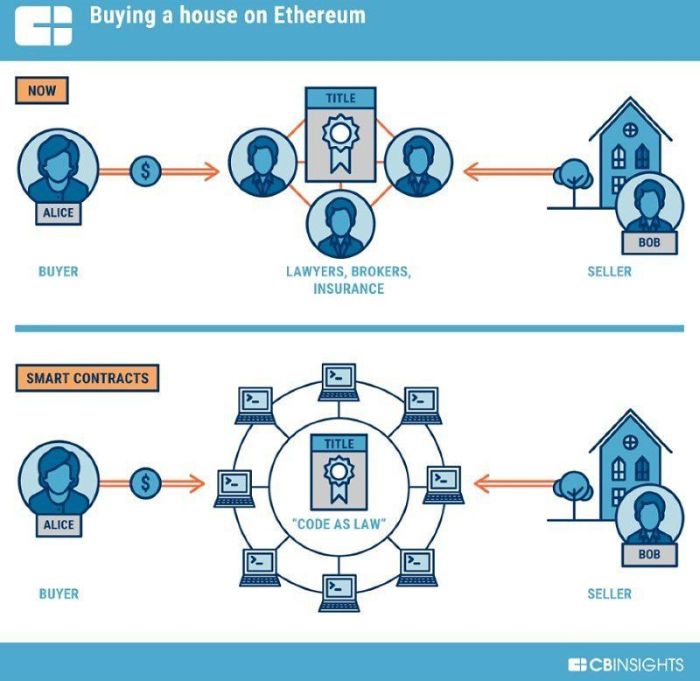Ethereum smart contracts pave the way for a new era of digital agreements and transactions, offering a glimpse into the future of secure and efficient contract execution. From coding to security considerations, the world of Ethereum smart contracts is as fascinating as it is revolutionary.
Introduction to Ethereum Smart Contracts

Ethereum smart contracts are self-executing contracts with the terms of the agreement directly written into code. They run on the Ethereum blockchain, eliminating the need for intermediaries and ensuring transparency and security.
Real-World Applications of Ethereum Smart Contracts
- Decentralized Finance (DeFi): Smart contracts are used for lending, borrowing, and trading digital assets without the need for traditional banks.
- Social Media Platforms: Content creators can receive instant payments based on view counts or engagement through smart contracts.
- Supply Chain Management: Smart contracts enable tracking and verifying the authenticity of products throughout the supply chain.
Benefits of Ethereum Smart Contracts
- Efficiency: Smart contracts automate processes, reducing the time and costs associated with manual contract handling.
- Transparency: Transactions on the Ethereum blockchain are visible to all parties involved, ensuring trust and accountability.
- Security: The decentralized nature of Ethereum blockchain makes smart contracts tamper-proof and resistant to hacking.
Coding Ethereum Smart Contracts
When it comes to coding Ethereum smart contracts, developers often utilize programming languages specifically designed for blockchain development. The most commonly used languages for writing Ethereum smart contracts are Solidity and Vyper.
Deploying Ethereum Smart Contracts on the Blockchain
Deploying Ethereum smart contracts on the blockchain involves a series of steps to ensure the contract is properly executed and accessible to users.
- Compile the Smart Contract: The first step is to compile the smart contract code using a compiler like Remix or Truffle.
- Deploy to the Blockchain: Once the contract is compiled, it needs to be deployed to the Ethereum blockchain using tools like MetaMask or Geth.
- Interact with the Contract: After deployment, users can interact with the smart contract through transactions on the blockchain.
Testing and Debugging Ethereum Smart Contracts
Testing and debugging Ethereum smart contracts is a crucial part of the development process to ensure the contract functions as intended and is free of vulnerabilities.
- Unit Testing: Developers can perform unit tests on individual functions within the smart contract to identify and fix any errors.
- Integration Testing: Integration testing involves testing how different components of the contract work together to ensure seamless functionality.
- Debugging: If any issues are identified during testing, developers can use debugging tools like Remix debugger to pinpoint and fix the problems.
Security Considerations for Ethereum Smart Contracts
When it comes to Ethereum smart contracts, security is paramount to prevent vulnerabilities that can lead to malicious attacks or breaches. Here, we will delve into common vulnerabilities, best practices for securing smart contracts, and notable security breaches involving Ethereum.
Common Vulnerabilities in Ethereum Smart Contracts
- Reentrancy: This vulnerability allows an attacker to repeatedly call a function before the previous execution is complete, potentially draining funds or causing unexpected behavior. To mitigate, use the “checks-effects-interactions” pattern and ensure all state changes occur before interacting with external contracts.
- Integer Overflow/Underflow: Operations with integer variables can lead to unexpected results if not properly handled. Use SafeMath library to prevent overflow and underflow vulnerabilities.
- External Contract Calls: Interacting with external contracts can introduce security risks, such as reentrancy attacks or unexpected behavior. Implement checks to validate external contract addresses and limit interactions to trusted contracts.
Best Practices for Securing Ethereum Smart Contracts
- Use Standard Libraries: Utilize well-tested libraries like OpenZeppelin to handle common security concerns and reduce the risk of vulnerabilities.
- Audit Smart Contracts: Conduct regular security audits by independent experts to identify potential vulnerabilities and ensure the code follows best practices.
- Implement Access Controls: Use access control mechanisms to restrict functions to authorized users and prevent unauthorized access or manipulation of the contract.
Notable Security Breaches Involving Ethereum Smart Contracts
- The DAO Hack: In 2016, a vulnerability in The DAO smart contract led to a hacker draining over $50 million worth of Ether. This incident resulted in a hard fork to reverse the transactions and recover the funds.
- Parity Wallet Hack: In 2017, a vulnerability in the Parity multi-signature wallet smart contract allowed a hacker to exploit the code and freeze over $150 million worth of Ether.
Interoperability of Ethereum Smart Contracts

Ethereum smart contracts have the unique ability to interact with other blockchains and platforms, allowing for cross-chain interoperability. This means that Ethereum smart contracts can communicate and transact with smart contracts on different networks, expanding their reach and functionality in the blockchain ecosystem.
Cross-Chain Interoperability and its Importance, Ethereum smart contracts
Cross-chain interoperability is crucial in the realm of smart contracts as it enables seamless communication and collaboration between different blockchain networks. This interoperability allows for the sharing of assets, data, and information across various platforms, enhancing the overall efficiency and effectiveness of smart contract applications.
- One example of a project enabling interoperability between Ethereum smart contracts and other networks is Polkadot. Polkadot is a multi-chain network that allows different blockchains to transfer messages and assets across chains, creating a connected and interoperable ecosystem.
- Another example is Cosmos, which provides a platform for interoperability between different blockchains through its Inter-Blockchain Communication (IBC) protocol. This protocol enables secure and trustless communication between Ethereum smart contracts and other blockchains, facilitating cross-chain transactions and data exchange.